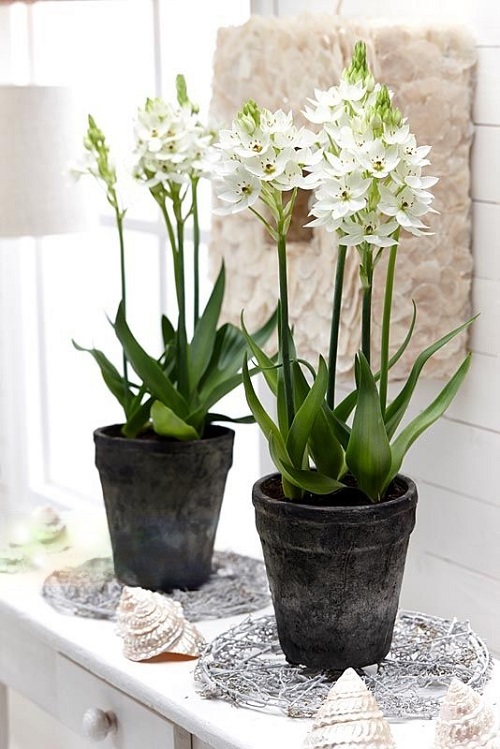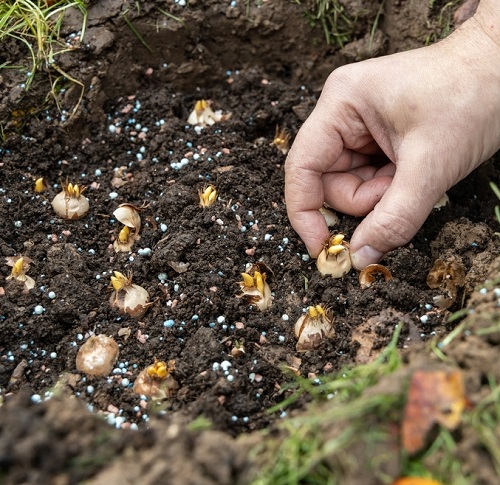Star of Bethlehem Flower is a very elegant specimen that you can grow for its elegant white blooms in both garden and pots!
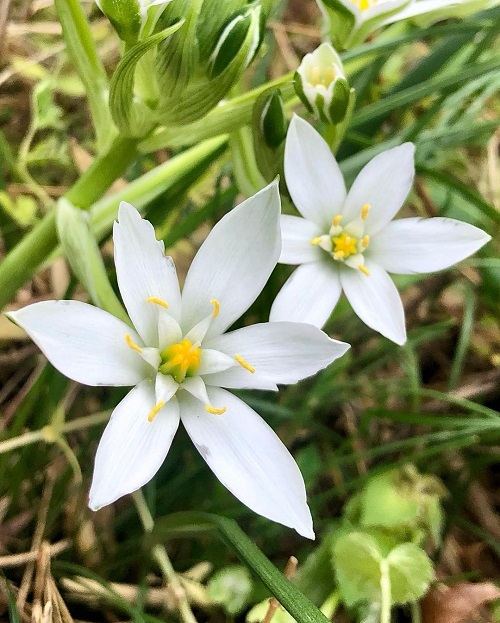
Growing Star of Bethlehem Flowers is effortlessly simple if you follow the right directions. This guide covers everything from soil preparation to maintenance, allowing you to relish their enchanting beauty in your garden.
Learn How to Grow Flowering Kalanchoe Indoors here
Star of Bethlehem Flower Information 
The Star of Bethlehem Flower (Ornithogalum umbellatum) is a perennial that forms clumps, featuring slender, grass-like leaves measuring approximately 1-2 feet in length. During late spring, flower stems emerge from the foliage, displaying clusters of star-shaped blooms, typically numbering between 10 to 20 and measuring less than an inch in diameter.
These flowers open in the late morning but close when the sun sets or under cloudy conditions. It exhibits rapid growth and has a tendency to spread quickly.
Read about Edelweiss Flower Care and Growing Information here
Propagating Star of Bethlehem Flowers
Over time, the bulbs of the Star of Bethlehem Flower will multiply abundantly, generating offsets or bulbils. Here are the steps to propagate the plant:
- Wait until Star of Bethlehem Flower has finished blooming and the foliage has died back. This is usually in late spring or early summer.
- Carefully dig up the bulbs using a garden fork or spade. Be sure to dig deep enough to avoid damaging the bulbs.
- Gently remove any excess soil from the bulbs and separate any offsets (small bulbs) that have formed.
- Discard any bulbs that are damaged or show signs of disease.
- Replant the bulbs immediately in well-draining soil, spacing them at least 3-5 inches apart. Make sure the bulbs are planted at the same depth as they were previously.
- Water the bulbs well after planting to settle the soil around the roots.
- Mulch the area around the bulbs with a layer of organic matter, such as leaves or straw, to help retain moisture and suppress weeds.
Learn about Growing Starfish Flower here
Requirements for Growing Star of Bethlehem Flower
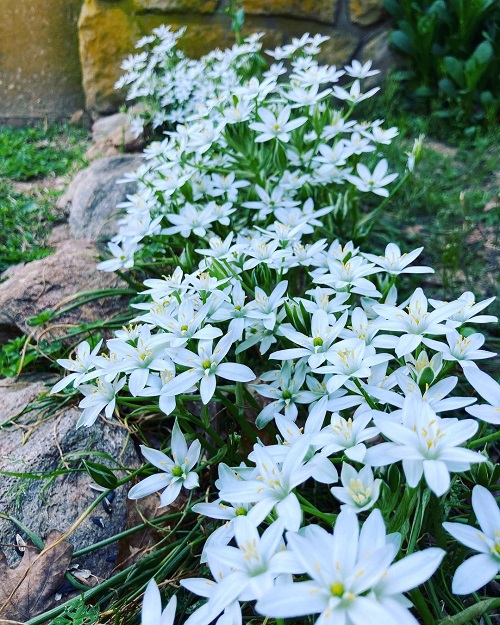
Location
While the Star of Bethlehem Flower can tolerate partial shade, it thrives in locations with full sun, receiving a minimum of 5-6 hours of direct sunlight on most days. Optimal flowering occurs when the plant is exposed to full sun.
Soil
Start with high-quality soil rich in organic matter, such as compost or well-rotted manure. This will provide the nutrients that the plant needs to grow and thrive.
Add perlite or coarse sand to the soil mix to improve drainage. Star of Bethlehem Flower prefers soil that is well-draining and does not like to sit in wet soil.
Learn some Great Tips to Rejuvenate Your Old Soil here
Mix in some peat moss or coconut coir to improve moisture retention. This will help keep the soil moist without allowing it to become waterlogged.
Water
To ensure the healthy development of Star of Bethlehem Flowers, it is important to provide regular watering, keeping the soil consistently moist but not waterlogged.
Mature plants exhibit some tolerance to dry soil, although they still prefer a moderate level of moisture. During the active growth period in spring and summer, it is advisable to water when the topsoil feels a little dry.
Here are the best ways to water plants
Temperature and Humidity
Star of Bethlehem Flowers prefers cool to moderate temperatures. It can tolerate temperatures down to -10°C (14°F) and up to 27°C (80°F). The ideal temperature range is between 15°C (59°F) and 21°C (70°F).
The plant prefers moderate to high humidity levels. It can tolerate low humidity levels, but this can lead to dry soil and slow growth. Aim for a humidity level of around 50% to 70% for best results.
Here are 10 Ways To Increase Humidity For Houseplants That Work
Star of Bethlehem Flower Care
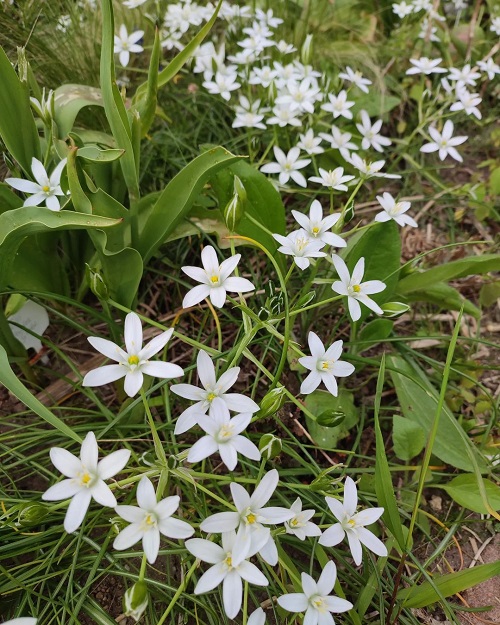
Fertilizer
Star of Bethlehem Flowers will benefit from a balanced liquid fertilizer once in 4-6 weeks. Do dilute the feed to 1/2 of its strength to ensure you don’t end up over fertilizing the plant.
Find out the Best Fruit Peels that are Brilliant Fertilizers here
Pruning
Once the Star of Bethlehem Flowers has completed its blooming cycle, you’ll be left with a cluster of tangled foliage that may not appear visually appealing.
However, it is crucial to refrain from removing this foliage. As long as it remains green, it serves as a source of nourishment for the bulbs through the process of photosynthesis.
Eventually, the leaves will turn brown, and during the summer months, the plants will enter a dormant phase, creating gaps in your garden bed. At this stage, it is appropriate to trim away the foliage.
Although removing the spent flowers does not stimulate further blooming, it does prevent the plant from spreading by eliminating the seeds that readily scatter throughout the garden when they fall.
Overwintering
The Star of Bethlehem Flower is known for its resilience. Nevertheless, gardeners residing in the northern regions of Zone 4 might consider safeguarding plants in exposed areas by applying a layer of dry mulch during the winter.
It is essential to prevent the bulbs from sitting in cold, waterlogged soil, as this can promote bulb rot.
Here are 9 Masterful Tips for Overwintering Balcony Garden Plants
In exceptionally frigid areas, an alternative approach is to dig up the bulbs and store them in a protected environment, such as a basement.
Pests and Diseases
The most common pests that can affect the Star of Bethlehem Flower are aphids and thrips. These pests can cause damage to the leaves and flowers of the plant and can reduce its overall health.
You can eliminate them with insecticidal soap or neem oil or by introducing natural predators such as ladybugs or lacewings.
In diseases, be careful of leaf spots and bulb rot. They can cause the leaves and flowers to become discolored and wilted and can ultimately lead to the death of the plant.
Ensure that the soil is well-draining and that the plant is not overcrowded. Fungicides can also be used to treat fungal diseases.

